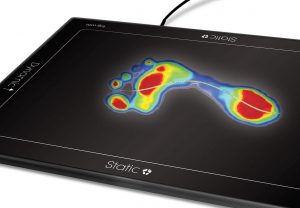Biomechanical assessment
 If you have pain when either walking or running in your lower limb then a biomechanical appointment can not only can diagnose and eradicate the pain but prevent further injury from occurring. During a biomechanical assessment appointment there are several distinctive parts to it. Firstly, the analyse of the problem starts with a thorough medical history and further questions regarding activity type and level.
If you have pain when either walking or running in your lower limb then a biomechanical appointment can not only can diagnose and eradicate the pain but prevent further injury from occurring. During a biomechanical assessment appointment there are several distinctive parts to it. Firstly, the analyse of the problem starts with a thorough medical history and further questions regarding activity type and level.
Once an overall picture has been painted then the practitioner will test the range of motion in certain key areas of the foot. This will then determine whether there is a problem in the structural integrity of the foot or if the problem presented is a soft tissue matter. Muscle strength in and around these important joints will also be tested to see if there are any weaknesses within the foot and ankle that needs addressed.
Seeing the patient standing allows the practitioner to see how the knees and hips are positioned for the first time. The foot is at the end of the kinetic chain and the positioning of this could have an effect further up the kinetic chain. Once standing the practitioner will observe the angles of the foot, knees and hips and will take note. Further range of motion at certain areas will be made at key areas and made a note off. Once this has been completed then the final part of the examination can begin.
The practitioner will then watch the patient during their natural dynamic gait cycle. This will be observing the positioning of the foot during initial contact, foot flat and the propulsion stage of gait. Not only will the foot positioning be observed but other factors such as arm swing and shoulder height will be noted. Once this has been completed then the patient will have a Gait Scan.
GaitScan technology is an innovative diagnostic tool and digital casting device that analyses a person’s gait in large detail. It is a computerised plate that once connected to computer software can take over 300 frames per second over 4096 pressure points when a person walks over it. It determines how the pressure is being displaced over the plantar aspect of the patient’s foot.
GaitScan provides a comprehensive biomechanical evaluation for each patient and allows for an in-depth report giving access to over one million data points. These data results and the professional understanding the practitioner has, will come up with an accurate diagnosis and will then proceed to give the patient a further understanding of how their own gait cycle is causing these issues.
Once this diagnosis has been concluded, then an effective treatment plan will be constructed. This treatment plan could be a mixture of lower limb exercises and a custom-made insole depending on the diagnoses.
